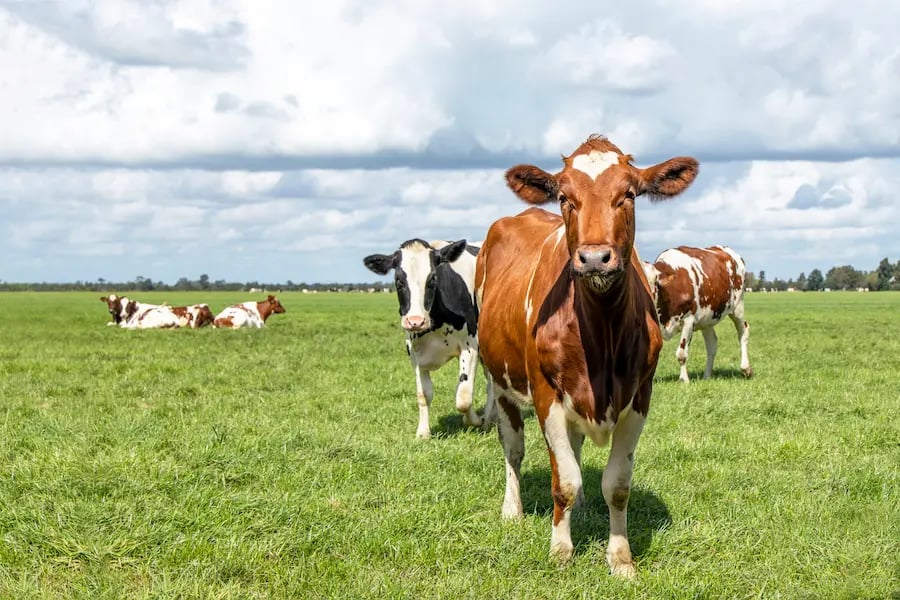Haemorrhagic bowel syndrome (HBS) is a gastrointestinal acute disease affecting cattle. Although this syndrome can affect all breeds, it is more common in dairy farming, particularly in high-production herds and particularly affects cows in early lactation. Although not everything is known about this syndrome, some elements are now consensual. This article summarizes the knowledge acquired and validated by experts on this disease.
What is the cause of the Hemorrhagic Bowel Syndrome?
The exact cause of HBS is still under discussion. However, it is accepted that Clostridium perfringens type A and a mold, Aspergillus fumigatus, play a role in the etiology of the disease. Several authors even consider Clostridium perfringens type A, and more specifically the alpha toxin it produces, to be the agent responsible for the disease. It is thought to act in synergy with Aspergillus fumigatus. However, as in the case of enterotoxemia, it is the proliferation of pathogens that is responsible for triggering clinical signs. Indeed, dietary alterations, such as sudden feed changes or high carbohydrate diets, can disrupt the microbial balance in the rumen, leading to acidosis and an increased risk of HBS. (Dennison et al., 2002; Peek et al., 2018 ; Cantor et al., 1999; Kirkpatrick et al., 2001; Ceci et al., 2006 ; Elhanafy et al., 2013).
What are the clinical signs of Hemorrhagic Bowel Syndrome?
The clinical signs of HBS include sudden anorexia, severe drop in milk production, abdominal distension, signs of colic and ileus, decreased fecal output, and diarrhea containing blood or blood clots. Animals show signs of profound depression, ruminal stasis, and may exhibit abdominal pain behaviors such as bruxism, vocalizations, and kicking at the abdomen. In severe cases, cows may exhibit signs of shock, including pale mucous membranes and increased heart and respiratory rates.
Auscultation and percussion may reveal audible fluid splashing sounds and pinging in the right middle portion of the abdomen due to gas production by Clostridium perfringens type A. Transrectal palpation may detect distended loops of the small intestine, inflated cecum, dilated colon, and a firm rumen. Death can occur within hours or up to 2 days following the onset of clinical signs.

The diagnosis of Hemorrhagic Bowel Syndrome
In live animals, diagnosis is based on clinical signs detailed above. These may be strongly suggestive of the disease. In addition, blood tests can be done. They may show changes in electrolyte imbalances, acid-base disturbances, and increased levels of liver enzymes. Fecal examinations can also be performed to rule out other causes of gastrointestinal diseases.
If the disease progresses to death, in addition to visible signs such as distention of the small intestine, dark red to purple coloration on the serosal surface and devitalization of proximal part of the small intestine, blood with or without clots in the intestinal lumen and intestinal mucosa, bacteriological tests to detect Clostridium perfringens should be carried out. It is crucial to collect samples from the affected parts of the intestine as soon as possible, preferably within 15 minutes after death, to increase the chances of an accurate diagnosis. However, it is important to note that isolating Clostridium perfringens type A or detecting its major toxin, alpha toxin, from feces or gastrointestinal content has limited diagnostic value since type A strains can also be found in the gastrointestinal tract of healthy animals. Bacterial counts of C. perfringens can be performed, but these results should be considered in conjunction with clinical or necropsy signs to approach a more definitive diagnosis (Dennison et al., 2005).
Is it possible to treat Hemorrhagic Bowel Syndrome?
The prognosis is severe. However, in the early stages, surgical treatment to manually advance blood clots from the injured area of the intestine may be considered. In addition, supportive therapy aiming to restore hydration and electrolyte balance in affected animals can be done. Similarly, non-steroidal anti-inflammatory drugs (NSAIDs) can be administered to relieve pain and reduce inflammation.

How to prevent Hemorrhagic Bowel Syndrome?
As the chances of successfully treating sick animals are low, it's best to implement preventive measures.
- Feeding: To reduce the risk of harmful molds, clostridial spores, and other bacteria, as well as their toxins, it is recommended to follow best management practices for proper storage of feed ingredients and ensiled forages. This includes avoiding feeding animals with moldy feeds, avoiding tilling excessively moist soil, raising the cutting height of corn and alfalfa, covering bunker silos with a suitable sheet, and leaving only the necessary amount of silage uncovered. To prevent the overgrowth and sporulation of Clostridium perfringens type A in the intestines, it is important to promote slow food transitions and provide diets rich in fiber to maintain a balanced intestinal flora. The quantity of fiber needed depends on the specific ration, so it is advised to consult with a nutritionist for appropriate recommendations. Additionally, attention should be given to stressful situations related to feeding or the environment, such as sudden changes in diet. The association between subacute rumen acidosis and HBS has been reported, so farms that have experienced HBS cases should monitor and control subacute ruminal acidosis. This can be achieved by evaluating ration fermentable carbohydrate and fiber levels, adjusting ration particle size, managing bunk space to minimize sorting, and providing an adequate level of effective fiber to maintain rumen health. Poorly ensiled feedstuffs should be discontinued, and forages should be evaluated for nutrient content, moisture, temperature, pH, and mycotoxins. In some cases, adding a mold inhibitor to the feed has been effective in reducing HBS incidence (Peek et al., 2018).
- Vaccination: As Clostridium perfringens type A and the alpha toxin it produces has been strongly indicated as causative agent of the syndrome, the use of a vaccine with high level of alpha toxin may have a beneficial effect to prevent Hemorrhagic Bowel Syndrome. Although opinions differ as to the efficacy of vaccination, it has been reported to reduce the prevalence of HBS by vaccinating 2-3 times a year. (Glock and Degroot, 1998).
Conclusion
Haemorrhagic bowel syndrome is a significant gastrointestinal disorder affecting cattle, leading to high morbidity and mortality rates. Understanding the causes, symptoms, and management strategies for HBS is crucial for effective prevention and treatment. Nutritional management and vaccination against alpha toxin of Clostridium perfringens can help minimize the impact of HBS.
References
Cantor, G. (1999). Jejunal hemorrhage syndrome: a new, emerging disease of dairy cows. Washington State Vet Med Assoc Newslett.
Ceci, L., Paradies, P., Sasanelli, M., De Caprariis, D., Guarda, F., Capucchio, M. T., & Carelli, G. (2006). Haemorrhagic bowel syndrome in dairy cattle: possible role of Clostridium perfringens type A in the disease complex. Journal of Veterinary Medicine Series A, 53(10), 518-523.
Dennison, A. C., VanMetre, D. C., Callan, R. J., Dinsmore, P., Mason, G. L., & Ellis, R. P. (2002). Hemorrhagic bowel syndrome in dairy cattle: 22 cases (1997–2000). Journal of the American Veterinary Medical Association, 221(5), 686-689.
Dennison, A. C., Van Metre, D. C., Morley, P. S., Callan, R. J., Plampin, E. C., & Ellis, R. P. (2005). Comparison of the odds of isolation, genotypes, and in vivo production of major toxins by Clostridium perfringens obtained from the gastrointestinal tract of dairy cows with hemorrhagic bowel syndrome or left-displaced abomasum. Journal of the American Veterinary Medical Association, 227(1), 132-138.
Elhanafy, M. M., French, D. D., & Braun, U. (2013). Understanding jejunal hemorrhage syndrome. Journal of the American Veterinary Medical Association, 243(3), 352-358.
Glock, R. D., & DeGroot, B. D. (1998). Sudden death of feedlot cattle. Journal of Animal science, 76(1), 315-319.
Kirkpatrick M, Timms L. Jejunal hemorrhage syndrome of dairy cattle, in Proceedings. Mid-South Ruminant Nut Conf 2004;47–59
Peek SF, McGuirk SM, Sweeney RW, Cummings KJ. (2018). Hemorrhagic Bowel Syndrome (Jejunal Hemorrhage Syndrome). In: Divers T, Peek SF, editor(s). Rebhun’s Diseases of Dairy Cattle. Third ed. St. Louis, Missouri: Elsevier. 311-5
About the author
Philippe Gisbert (Ruminants Global Technical Manager)
Philippe Gisbert started his career in 1994 as a Vet practitioner working with companion and farm animals for over 9 years. He then became Health Affairs Manager for Group Agena (artificial insemination company). In 2008 he joined Eurofins – Laboratoire Coeur de France as Animal Health Unit Manager where he worked for 7 years until he joined Ceva France as Technical Manager Ruminants (Infectiology, Vaccines and Diagnostic). Since 2020 he is Global Technical Manager for Biologicals, Udder Health and Antiinflammatories. He is a member of SIMV diagnostic and anti-infective technical groups and has integrated different working groups of ANSES and UNCEIA related to epidemiology, antibiotic resistance and reproduction in livestock.
Explore author’s articles



Leave your comments here